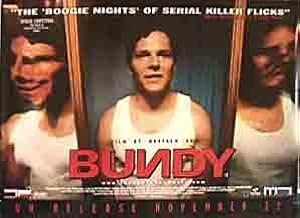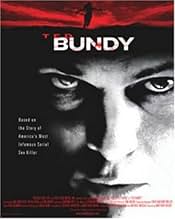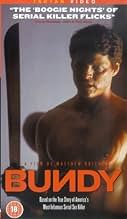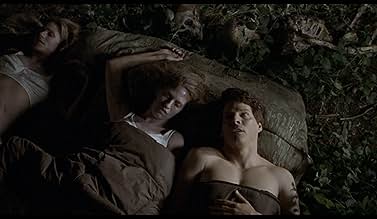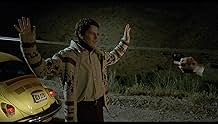VALUTAZIONE IMDb
5,8/10
8475
LA TUA VALUTAZIONE
La storia del serial killer Ted Bundy.La storia del serial killer Ted Bundy.La storia del serial killer Ted Bundy.
- Regia
- Sceneggiatura
- Star
- Premi
- 3 candidature totali
Boti Bliss
- Lee
- (as Boti Ann Bliss)
Annalee Autumn
- Girl Attacked on Street
- (as Anna Lee Wooster)
Samantha Tabak
- Vincennes
- (as Tricia Dickson)
Eric DaRe
- Male Partygoer
- (as Eric Dare)
Renee Intlekofer
- Cutler
- (as Renee Madison Cole)
Recensioni in evidenza
Be prepared to leave your lights on in order to sleep for at least three days after first viewing this morbidly fascinating account of mass-murdering, intelligent sociopath Ted Bundy and his descent into soul-less depravity. As a study in human nature gone wrong, this is a fascinating body of work. Particularly because this movie is, unfortunately, based on the facts, I am grateful that the viewer is not forced to witness Bundy's every demonic act, though little is actually left to mystery. Chilling, thought-provoking, disturbing, tragic, and well-made, this movie is an often shocking account of one cold-blooded monster's reign of terror.
The best part for this viewer is that the movie allows us to see Bundy sentenced to death.
A. Freimann
The best part for this viewer is that the movie allows us to see Bundy sentenced to death.
A. Freimann
I have seen almost every serial killer movie ever made. I, also work in the mental health field. Combining this information, I still cannot completely believe what I just watched. Someone in the production was privied to actual mental health knowledge, because this presentation was very realistic. The TV movie dealt with the obsession, but not with the actual disease. This version dealt with the progression of violence and the increasing brazeness of the psychotic mind. Sometimes, it is hard to watch realistic violence, and separate it from every day violence. The director nailed the unstable personality traits to a tee. Ted Bundy was an animal and a human being, waiting for his true love. There never was one and he paid the ultimate price. If, only Clozaril had been available then.
Alan Sheldon
Alan Sheldon
What is the point of making this movie? Next to this, the TV series, "The Deliberate Stranger," is a masterpiece of information and good taste. I suppose it was inevitable that sooner or later it would occur to someone that there was a nickel or two left in the story of Ted Bundy, who slaughtered and raped all those young women and was put to death for it.
But how to improve on the TV series? Simple, you throw out almost all of the background involving family and police and leave in the murders, only this time, this being a feature film, you can show the slaughters and the rapes in all their gory detail.
Mission accomplished. It's a disgusting and exploitative movie. We don't get to know any of the victims of course. They're as faceless as the guys that Dirty Harry shoots during a holdup. Nothing about their families of course. Nothing about Ted Bundy either, for that matter -- not that there's very much to know about a major anti-social personality who invents himself as he goes along. Why does he kill? He has a little speech he makes to his girl friend about finding out that he was illegitimate, but so what? Who knows? Who cares? We don't know how the police manage to catch him twice. All of that sort of thing would detract from the time devoted to the murders. If we learned anything more about the police or about Ted, we'd be able to see fewer bloody naked female bodies being slung about. Only the juicy parts of the story are left in, with just enough non-juicy stuff for the film makers to deny that only the juicy parts of the story are left in.
The last murder we see is that of Ted Bundy himself. He's electrocuted in Florida. Does the director skip any details of this final death? Are you kidding? We get to learn so much about how electrocutions are carried out that we could probably follow the procedure as well as the professionals. I'll bet you didn't know that before the victim becomes part of a serial circuit with the chair he has cotton forced into his rectum and made to wear Depends. The ghouls must be jumping in their seat with excitement. More time is spent on the electrocution (almost 10 minutes) than on any of the other deaths in the movie. If this isn't "pandering" then the word has no referent at all.
The acting is passable. The direction, aside from the content of the movie, isn't objectionable. It's not very good either. Okay -- example. Bundy escapes from prison. The whole country is searching for him. Cut to his former girl friend sleeping alone in her bed. The door to her room slowly opens and Bundy enters without a shirt but holding a machete. He tiptoes to the bed, raises the knife above his head, and -- WHACK. But what do you know, folks. It's a nightmare. We know it's a nightmare because the girl wakes up screaming and shoves her face into the camera lens. I don't know how far back in cinematic history this hoary device goes, the wakee sitting up and screaming into the lens. The first time I remember seeing something like it was, I think, in "Carrie," about a quarter of a century ago. It was an effective shocker -- once. Now it's almost obligatory. Instead of wincing, you yawn. (I also think a moratorium should be placed on scenes in which a patient is being wheeled hurriedly on a gurney down a hospital corridor and the camera takes the patient's point of view, so we see all these worried faces staring down into the lens and snapping medical-type orders at one another. While we're at it, let's have a moratorium on any further commercial use of Beethoven's ninth symphony. Let's throw in Edward Hopper's "Nighthawks," too.)
There is an especially nauseating scene of Bundy chasing a girl through the woods. He's just kidnapped her from the beach, so she's wearing only a skimpy bikini. She's running, howling, falling down, getting up, running again with the camera a few feet behind her at every step, every fall, so that the viewer gets a good sexy view of her wobbling buttocks before Bundy catches her and bashes her brains out. The shot may have been plagiarized from "I Spit on Your Grave," which see.
I'm happy that censorship is relaxed enough to allow gore on screen but this film provides an exercise in the use of moral restraint. Just exactly who are we supposed to identify with while the camera follows the terrified victim through the woods? What pleasure is to be derived from simply looking at the butchery of strangers? What comes next? Should we skip ALL of the background details, drop any concern with insight or ethics, and just have one and a half hour's worth of some nameless monster chopping up nameless bodies and splattering everything with blood and intestines? If that's not the direction in which a film like this points, then what IS the reason it was made in the first place?
But how to improve on the TV series? Simple, you throw out almost all of the background involving family and police and leave in the murders, only this time, this being a feature film, you can show the slaughters and the rapes in all their gory detail.
Mission accomplished. It's a disgusting and exploitative movie. We don't get to know any of the victims of course. They're as faceless as the guys that Dirty Harry shoots during a holdup. Nothing about their families of course. Nothing about Ted Bundy either, for that matter -- not that there's very much to know about a major anti-social personality who invents himself as he goes along. Why does he kill? He has a little speech he makes to his girl friend about finding out that he was illegitimate, but so what? Who knows? Who cares? We don't know how the police manage to catch him twice. All of that sort of thing would detract from the time devoted to the murders. If we learned anything more about the police or about Ted, we'd be able to see fewer bloody naked female bodies being slung about. Only the juicy parts of the story are left in, with just enough non-juicy stuff for the film makers to deny that only the juicy parts of the story are left in.
The last murder we see is that of Ted Bundy himself. He's electrocuted in Florida. Does the director skip any details of this final death? Are you kidding? We get to learn so much about how electrocutions are carried out that we could probably follow the procedure as well as the professionals. I'll bet you didn't know that before the victim becomes part of a serial circuit with the chair he has cotton forced into his rectum and made to wear Depends. The ghouls must be jumping in their seat with excitement. More time is spent on the electrocution (almost 10 minutes) than on any of the other deaths in the movie. If this isn't "pandering" then the word has no referent at all.
The acting is passable. The direction, aside from the content of the movie, isn't objectionable. It's not very good either. Okay -- example. Bundy escapes from prison. The whole country is searching for him. Cut to his former girl friend sleeping alone in her bed. The door to her room slowly opens and Bundy enters without a shirt but holding a machete. He tiptoes to the bed, raises the knife above his head, and -- WHACK. But what do you know, folks. It's a nightmare. We know it's a nightmare because the girl wakes up screaming and shoves her face into the camera lens. I don't know how far back in cinematic history this hoary device goes, the wakee sitting up and screaming into the lens. The first time I remember seeing something like it was, I think, in "Carrie," about a quarter of a century ago. It was an effective shocker -- once. Now it's almost obligatory. Instead of wincing, you yawn. (I also think a moratorium should be placed on scenes in which a patient is being wheeled hurriedly on a gurney down a hospital corridor and the camera takes the patient's point of view, so we see all these worried faces staring down into the lens and snapping medical-type orders at one another. While we're at it, let's have a moratorium on any further commercial use of Beethoven's ninth symphony. Let's throw in Edward Hopper's "Nighthawks," too.)
There is an especially nauseating scene of Bundy chasing a girl through the woods. He's just kidnapped her from the beach, so she's wearing only a skimpy bikini. She's running, howling, falling down, getting up, running again with the camera a few feet behind her at every step, every fall, so that the viewer gets a good sexy view of her wobbling buttocks before Bundy catches her and bashes her brains out. The shot may have been plagiarized from "I Spit on Your Grave," which see.
I'm happy that censorship is relaxed enough to allow gore on screen but this film provides an exercise in the use of moral restraint. Just exactly who are we supposed to identify with while the camera follows the terrified victim through the woods? What pleasure is to be derived from simply looking at the butchery of strangers? What comes next? Should we skip ALL of the background details, drop any concern with insight or ethics, and just have one and a half hour's worth of some nameless monster chopping up nameless bodies and splattering everything with blood and intestines? If that's not the direction in which a film like this points, then what IS the reason it was made in the first place?
This movie is not for the faint-of-heart; it's a story about a vicious serial killer, and does not pretty up the subject matter. Thus there are numerous scenes of bloody and perverse sex, dead bodies galore, lots of profanity, and an overall atmosphere of sickness. None of this is pleasant to watch, but is entirely appropriate for the subject matter.
The script stays close to fact, although it leaves out some important information; neglecting, for example, to mention that one woman Bundy approached at Lake Sammamish refused to follow him into the parking lot. Her evidence provided a description and a name to a previously faceless monster, the first real lead the police had in the case. The movie also fails to give any real sense of the era in which Bundy flourished. In the swinging seventies, it was not so uncommon for women to get into cars or otherwise accept approaches from total strangers -- one reason for Bundy's success.
This film suffers from a lack of focus and purpose. It does give a good sense of the progression of Bundy's hideous career: the burglarizing, purse-snatching, shoplifting peeping tom gradually deteriorates into the brutal, raping, murdering serial killer. We see his alcoholism, his ability to be totally charming when necessary, and his knack for attracting "enabling" girlfriends into his life. What we don't see is anything of the inner Bundy. Granted, any depiction of the "inner Bundy" would be pure speculation, but a good movie would at least make an attempt to give some motive for Bundy's violent compulsions. All this movie does is make some vague references to his illegitimacy.
I need to also mention the incredibly poor taste in background music. In some sequences, light-hearted music is playing while Bundy is committing heinous acts of violence. (Christmas music in one case!) Perhaps the director meant to indicate that all this horror was just plain fun to Bundy; but the effect is to cheapen the scenes and even make them comic.
The verdict: Iffy. Lacks depth, and occasionly shows poor taste. Leaves out important information. On the plus side, it is well-acted, and does not attempt to sugar coat the ugly facts of violence. If you want a thoughtful examination of Bundy's character and the era in which he lived, this is not the right movie.
The script stays close to fact, although it leaves out some important information; neglecting, for example, to mention that one woman Bundy approached at Lake Sammamish refused to follow him into the parking lot. Her evidence provided a description and a name to a previously faceless monster, the first real lead the police had in the case. The movie also fails to give any real sense of the era in which Bundy flourished. In the swinging seventies, it was not so uncommon for women to get into cars or otherwise accept approaches from total strangers -- one reason for Bundy's success.
This film suffers from a lack of focus and purpose. It does give a good sense of the progression of Bundy's hideous career: the burglarizing, purse-snatching, shoplifting peeping tom gradually deteriorates into the brutal, raping, murdering serial killer. We see his alcoholism, his ability to be totally charming when necessary, and his knack for attracting "enabling" girlfriends into his life. What we don't see is anything of the inner Bundy. Granted, any depiction of the "inner Bundy" would be pure speculation, but a good movie would at least make an attempt to give some motive for Bundy's violent compulsions. All this movie does is make some vague references to his illegitimacy.
I need to also mention the incredibly poor taste in background music. In some sequences, light-hearted music is playing while Bundy is committing heinous acts of violence. (Christmas music in one case!) Perhaps the director meant to indicate that all this horror was just plain fun to Bundy; but the effect is to cheapen the scenes and even make them comic.
The verdict: Iffy. Lacks depth, and occasionly shows poor taste. Leaves out important information. On the plus side, it is well-acted, and does not attempt to sugar coat the ugly facts of violence. If you want a thoughtful examination of Bundy's character and the era in which he lived, this is not the right movie.
I rented this because I expected it to be intense, having seen Matthew Bright's work in "Freeway". It's definitely that. It's hard not to compare it to "The Deliberate Stranger": each focuses on a different aspect of Bundy's story. "Stranger" focused more on the investigation and the actual facts, and Mark Harmon's performance captured the smoothness and charm which enabled Bundy to gain his victims' trust. This movie is all about the animal beneath. In reality, Bundy's ability to keep that beast hidden was part of what enabled him to carry on as long as he did. This film lays bare that monster, and shows it in all its ugliness. I'm seeing a lot of criticism of this movie for being good at what it set out to do: to make you share in the revulsion of what Ted Bundy was. Complaining that it's in bad taste? What does 'taste' have to do with a sadistic animal who snuffed out dozens of young womens' lives, just to fulfill his need to feel powerful? In this respect, this movie is superior to "Stranger": that one is much too tame and sanitized. What kind of hypocrite watches a movie about a serial killer, and complains that it's too lurid? While "Stranger" is more successful as a factual and interesting telling of Bundy's story, this is a much more impactful movie that makes you feel as though you're actually in the room with that demon. Only 15 minutes into the movie, I felt filthy just from watching his odious behavior. Bright's purpose here was not so much to make a biography as it was to use Bundy's story to point out something fundamental about human nature: the desire for control, and how it drives us to harm each other. While not as good as Bright's earlier "Freeway", it's still a good, disturbing movie, much in the brutal vein of "Henry, Portrait of a Serial Killer". It's actually much more violent - especially sexually - than the latter, though not as gruesome.
Lo sapevi?
- QuizIn the scene when Ted and his girlfriend Lee are celebrating with friends at a party, a woman walks up to Lee introducing herself as "Beverly" and talks to her about working with Ted at a crisis center. Her character is clearly a reference to Ann Rule, a true-crime author who met and worked with the real Ted Bundy at a crisis center in Seattle, Washington during the early 1970s. Furthermore, Rule did, in fact, meet and talk with the real Ted Bundy's girlfriend at a Christmas party one year. Rule would later write a book about Bundy and his murders.
- BlooperEarly on in the movie Ted attacks a woman with a hammer handle. As he grabs her, the handle - which is supposed to be hard wood - bends at the base to reveal that it is rubber.
- ConnessioniReferenced in Vintage Video: Forbidden Zone (2020)
- Colonne sonoreMartha's Street
by Dominic Glynn (uncredited) and Martin Smith (uncredited)
Published by Chappell Recorded Music Library
I più visti
Accedi per valutare e creare un elenco di titoli salvati per ottenere consigli personalizzati
- How long is Ted Bundy?Powered by Alexa
Dettagli
Botteghino
- Budget
- 1.200.000 USD (previsto)
- Lordo Stati Uniti e Canada
- 6073 USD
- Fine settimana di apertura Stati Uniti e Canada
- 1710 USD
- 15 set 2002
- Lordo in tutto il mondo
- 68.716 USD
- Tempo di esecuzione1 ora 39 minuti
- Colore
- Mix di suoni
- Proporzioni
- 1.85 : 1
Contribuisci a questa pagina
Suggerisci una modifica o aggiungi i contenuti mancanti



